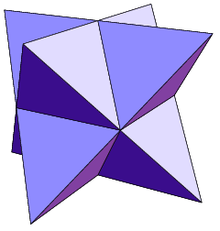Star tetrahedron
The star tetrahedron , also known as the star body to the octahedron (even if it is not a star body , since the same number of surfaces do not meet in all corners) and as the Kepler star, is an eight-pointed star and belongs to the non- convex deltahedra . It is a multi-faceted body that is created by merging two point-symmetrical tetrahedra . Named by Johannes Kepler (hence the name "Keplerstern") in 1609, this is both the simplest regular composite polyhedron and the simplest non- convex uniform polyhedron. He was first depicted by Leonardo da Vinci in Luca Pacioli's De Divina Proportione 1509.
The outer corner points of the body describe a cube , while the intersection of the two tetrahedra represents an octahedron , the edges of which in turn represent the inner edges of the star tetrahedron.
The graphic artist MC Escher used the star tetrahedron as a motif for the picture Doppelplanetoid : One tetrahedron has the shape of a castle inhabited by humans, while the other represents a world penetrated by the first and inhabited by dinosaurs.
The star tetrahedron is the first stage of the convex shape of the Sierpinski octahedron . The eight small tetrahedra can be made into star tetrahedra again, and this process can be repeated, so that finally a fractal is created, which approximates the shape of a hexahedron .
Formulas
| Sizes of a star tetrahedron with edge length a or b = a / 2 | |
|---|---|
|
Volume ≈ 0.18 a 3 |
|
|
Surface area ≈ 2.6 a 2 |
|
|
Umkugelradius ≈ 0.61 a |
|
- The volume of the star tetrahedron is equal to the sum of the volumes of one octahedron and eight attached tetrahedra, each with half the edge length . It fills half of the bounding cube ( ).
- The spherical radius of the star tetrahedron corresponds to that of a single tetrahedron.
Application in art
Wall painting of a star tetrahedron in the Boris and Gleb Church in Kidekscha
Jovilliers Abbey ( Stainville , Lorraine)
Web links
- Eric W. Weisstein : Star Tetrahedron . In: MathWorld (English).
Individual evidence
- ↑ MC Escher: Double Planetoid .
- ↑ Keplerian Fractals ( Memento of the original from March 16, 2015 in the Internet Archive ) Info: The archive link was inserted automatically and has not yet been checked. Please check the original and archive link according to the instructions and then remove this notice.
- ↑ Approaching a Fractal Cube by a series of non-convex polyhedra
- ↑ Keplerian fractals









